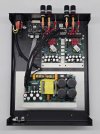The RCA mess is only with 16dB gain.
How would that measure when used after an AVR with weak pre-outs for example where 32dB gain would be needed?
It seems as there's something broken in there.
Exactly. The whole test is something of a muddle because of the test selections, too, in my view. Full output appears to be over 300W into 8 ohms if measured at the traditional 1% THD vs the arbitrary "pick a point on the plot" used for the "tested" figure. At the lowest gain of 11dB the voltage required to drive that output is off the chart. Literally. It's so absurd that it's off the boundaries of my handy reference chart. 10 or 15 volts or more.
Most preamps won't drive this to full output at that setting. Even at 16dB gain, it's still crazy high--over 7V from the preamp. Many quality preamps won't even drive that. So why test there? 22dB will be the most common gain level for separates, where 4V is usually available (which is about what would be needed to drive it to full output). But, for a truly
fair comparison, one would need to use the 32dB gain setting, which is where *most* amps are fixed at [edit: if they have this much output power]. How it performs with an 11dB or 16dB gain structure is more of a curiosity than anything. Few will even use those gain settings.
Unfortunately, we don't know how it does when set to "normal" mode. It's going to be worse. With an RCA input, it already falls apart. And the distortion in higher frequencies shows a lot of nonlinearities and issues typically of many Class Ds. Audible? I don't know, but I don't like it. Never have. It's just flat out poor performance, albeit remarkably decent
... for a Class D. It basically performs on par (via RCA input) just below state of the art in 1978. The only nice thing here is that it weighs very little for the power. That's new, at least. That's what Hypex brought to the table (along with dozens of "manufacturers" all selling the same thing). As for reliability, we'll see. For what Monoprice/ATI are selling US made Monolith amps for these days, I really don't understand the appeal of these things for 2 channel except for the space constrained. And just which space constrained person needs 300/500 watts? "Space constrained" says bookshelf system. With "real" speakers there is probably room for a "real" amplifier that weighs 80 pounds and probably won't break and be unrepairable. I guess I'm just curmudgeonly, even if I'm not old yet...



